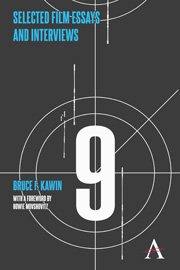Book contents
- Frontmatter
- Contents
- Foreword
- Preface
- PART I VIOLENCE AND POLITICS
- PART II HORROR AND SCIENCE FICTION
- PART III REVIEWS
- PART IV INTERVIEWS
- PART V LITERATURE AND NARRATION
- 14 The Montage Element in Faulkner's Fiction
- 15 Horton Foote
- 16 An Outline of Film Voices
- 17 Dorothy's Dream: Mindscreen in The Wizard of Oz
- PART VI GETTING IT RIGHT
- Acknowledgments
- Index of Names and Titles
16 - An Outline of Film Voices
from PART V - LITERATURE AND NARRATION
Published online by Cambridge University Press: 05 May 2013
- Frontmatter
- Contents
- Foreword
- Preface
- PART I VIOLENCE AND POLITICS
- PART II HORROR AND SCIENCE FICTION
- PART III REVIEWS
- PART IV INTERVIEWS
- PART V LITERATURE AND NARRATION
- 14 The Montage Element in Faulkner's Fiction
- 15 Horton Foote
- 16 An Outline of Film Voices
- 17 Dorothy's Dream: Mindscreen in The Wizard of Oz
- PART VI GETTING IT RIGHT
- Acknowledgments
- Index of Names and Titles
Summary
Mindscreen examined first-person cinema, and this article added second- and third-person cinema to the mix, enhancing what is proposed and, I think, delivered here: a description and organization of voices in the cinematic narrative system. The discussion of interactive cinema needs to be updated in terms of today's and tomorrow's computers, but the category exists. This was published in Film Quarterly in 1985.
In his recent Film (Quarterly article, “Tense, Mood, and Voice in Film: Notes after Genette, ” Brian Henderson initiated a stimulating attempt to rethink film narration in terms suggested by his reading of Gerard Genette's Narrative Discourse. While I agree with him that the problem of narration—of who says what and how it gets said—is fundamental, and a useful site for interrelating our understandings of literature and film, I remain disturbed by his discussion of point of view and voice-over narration—particularly with his implication that they and subjective camera account for most of what could be called first-person cinematic narration—and with some of his remarks about what can and cannot happen in literature and film. What I should like to do here is to take issue with a few specific points raised in that article, and then go on to present an expansion of my argument in Mindscreen1 concerning film voices.
- Type
- Chapter
- Information
- Selected Film Essays and Interviews , pp. 153 - 166Publisher: Anthem PressPrint publication year: 2013



